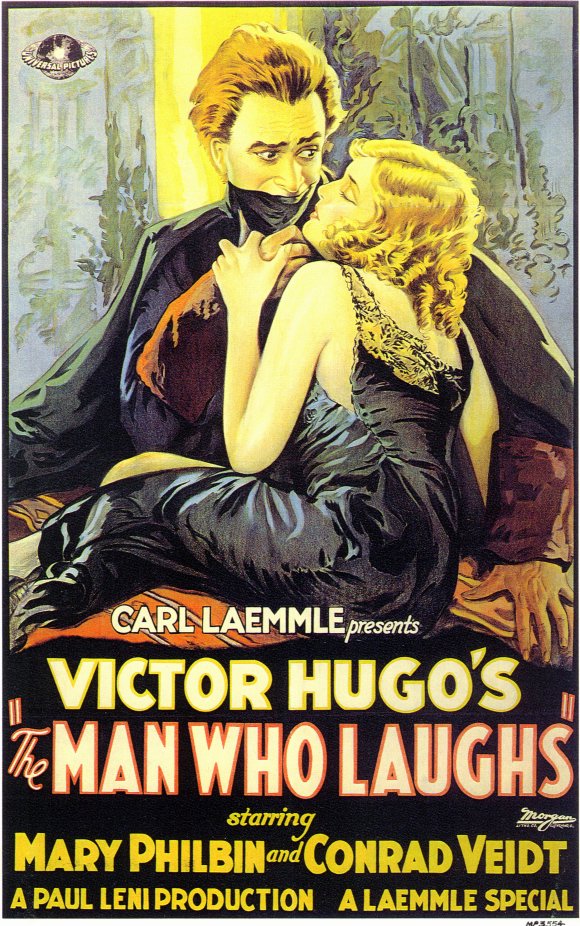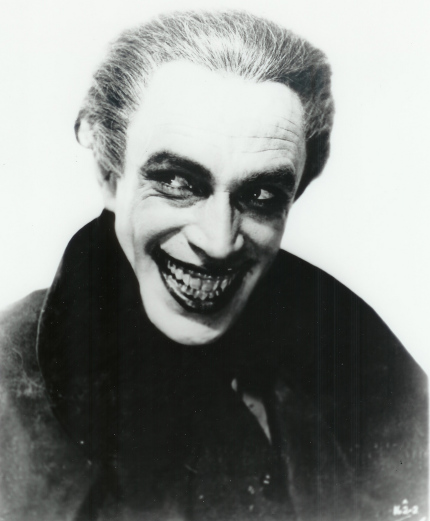Classic Universal Monsters #3 & 5 – THE MAN WHO LAUGHS / THE INVISIBLE MAN
This Halloween season I've been talking about some classic Universal Horror Films. Universal Pictures was pretty much built on their classic horror movies. All of the horror movies that they have made, have pretty much set the standard for horror films and the way that we view these classic monsters today. I consider all of these films favorites of mine. Whenever we hear the name Frankenstein, Wolfman or Dracula, we automatically associate that monster with what Universal envisioned back in the early days of filmmaking. I thought it would be cool to share my favorite Universal Horror films and monsters. The last two films I will be discussing this Halloween are, The Man Who Laughs and The Invisible Man.
The Man Who Laughs

This is a silent film made in 1928 by German Expressionist filmmaker Paul Leni. It’s an adaptation of Victor Hugos novel of the same name, and it stars Conrad Veidt. I don’t know many people who have heard of this film let alone seen it, but it is a fantastic movie! The reason it falls into the horror genre is due to the grim Carnival freak like grin on the character Gwynplaine's face, which served as the inspiration for the joker in Batman. Roger Ebert stated "The Man Who Laughs is a melodrama, at times even a swashbuckler, but so steeped in Expressionist gloom that it plays like a horror film." It truly is a wonderfully made silent film that needs to be seen by those film geeks that haven't seen it yet.
The story takes place in England in the year 1690, The Man Who Laughs features Gwynplaine, the son of an English nobleman who has offended King James II. The monarch sentences the nobleman to death in an iron maiden, and calls upon a surgeon, Dr. Hardquannone, to disfigure the boy's face into a permanent rictus grin. As a title card states, the King condemns him "to laugh forever at his fool of a father."
The Invisible Man

This 1933 horror film is an adaptation of H.G. Wells classic novel of the same name. The film stars Claude Rains in his first American screen appearance, and he’s spends most of his time on screen wrapped up in bandages, he is only shown clearly for a brief time at the end of the film. He is not seen 95% of the movie! It’s one of the great Universal Horror films of the 1930s, and spawned a number of sequels, plus many spinoffs using the idea of an "invisible man" that were largely unrelated to Wells' original story.
Here are a few little details you may have not known about the film:
Boris Karloff had been the studio's original choice for the role of the Invisible Man. He turned down the role because he would not be seen on screen until the end. Director James Whale wanted someone with more of an "intellectual" voice than Karloff. He selected Claude Rains after accidentally hearing Rains's screen test being played in another room. (Until this film, Rains had primarily been a stage actor. Although he had appeared in one silent movie in 1920, this was his first sound film.)
In order to achieve the effect that Claude Rains wasn't there when his character took off the bandages, the director had Rains dressed completely in black velvet and filmed him in front of a black velvet background.
In a short documentary, Claude Rains' daughter tells of a time when the two went to see this movie in the theater years after it was made. It was bitterly cold and his face was completely covered by a hat and scarf. When he spoke to ask for the tickets, the attendant immediately recognized his voice and let them in for free.
Although the actor under the bandages was usually Claude Rains, particularly in the sequence set at the inn, often it was a double. You can tell him apart from the real Claude Rains because he is taller and has aquiline features, with a nose so prominent that it is visible even through the bandages. Rains's dialogue was all pre- or post-recorded and dubbed onto the soundtrack.
When screenwriter R.C. Sherriff came to Hollywood to write The Invisible Man (1933), he asked the staff at Universal for a copy of the H.G. Wells novel he was supposed to be adapting. They didn't have one; all they had were 14 "treatments" done by previous writers on the project, including one set in Czarist Russia and one set on Mars. Sherriff eventually found a copy of the novel in a secondhand bookstore, read it, thought it would make an excellent picture as it stood, and wrote a script that (unlike the Universal versions of Dracula (1931) and Frankenstein (1931)) was a closer adaptation of the book.
I really hope you enjoyed our Universal Horror film discussions. It always fun for me to watch these movies again, and then go out and do some research on them to find some stuff that you all might find interesting. Happy Halloween!